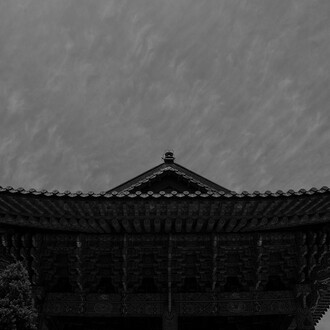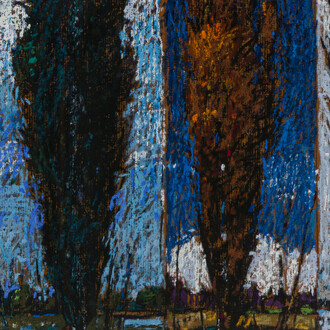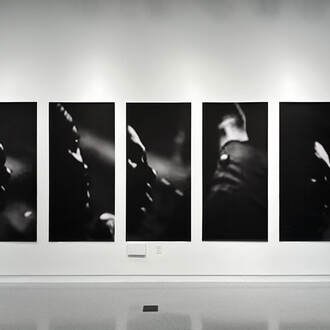Matthew Brown is pleased to present Compression, a group exhibition featuring works by Uri Aran, Huma Bhabha, Nat Faulkner, Kenji Ide, Mark Manders, Yu Nishimura, and Julia Yerger.
Spanning drawing, collage, sculpture, photography, and painting, the exhibition investigates the formal and conceptual possibilities of compression. Examining compression as both a method and a framework, each of the artists condenses form, collapses space, and distills materials as they explore its influence on imagery, materiality, and spatial construction. Whether through sculptural density, visual abbreviation, or the spatial flattening of bodies and symbols, Compression explores the tension and limits of containment, and considers how the various modes of compression can yield distinct forms of expression.
Uri Aran (b. 1977, Jerusalem, Israel) works across various mediums, including painting, drawing, sculpture, installation, video, performance, and photography, blending abstraction with universally recognized symbols to explore the nuances between communication and interpretation. Familiar tropes in his work—such as childhood television characters, chips ahoy cookies, flowers, googly eyes, and animals—are often integrated into or contrasted with abstraction. Across his two sculptures and the work on paper, Aran compresses diverse materials and marks into constrained formats, distilling each composition into a calibrated balance of logic and sensation.
Huma Bhabha (b. 1962, Karachi, Pakistan) is known for her monumental sculptures and works on paper that reimagine the figure and its expressive potential. In her two-dimensional work, she combines drawing, collage, and photography, weaving together references to ancient, modern, and cross-cultural art traditions to evoke both the human and the otherworldly. In her works on paper, Bhabha compresses photography, gesture, and collage into a single plane, generating a dense surface and a heightened sense of proximity.
Nat Faulkner (b. 1995, Chippenham, England) works across experimental sculpture and analogue photography, treating his studio darkroom as a darkroom and laboratory for photographic chemistry. Embracing imperfection, chance, and chemical slippage, his hand-printed works—often on plywood, aluminium, or glass— photography’s uncertainty, malleability, and tactile presence. Though working in a large format, Faulkner scales his photographs down, positioning them within expansive black margins. These margins preserve marks from his singular studio process, in which photographic negatives are handled and printed as objects.
Kenji Ide (b. 1981, Yokosuka, Japan) creates wooden sculptures that give form to intimate settings, recollections, and daily wonders. Shaped from materials that hold personal significance and reflect his local surroundings, the sculptures often begin with walks alongside his family, during which his children point out landscape features, architectural details, and collect small objects that may later find their way into the works. Ide’s two sculptures, The circulation of unconscious and Lively shades of things, are signature examples of his ability to take expansive ideas—rooted in memory, narrative, and cultural reference—and compress them into intimately scaled forms.
Mark Manders (b. 1968, Volkel, The Netherlands) has developed an endless self-portrait, titled “self-portrait as a building,” in the form of sculpture, still life, and architectural plans. Consisting of the totality of his practice, this ongoing self-portrait consists of writing, figuration, everyday items, invented forms, and architectural elements, His timeless and distinctly non-linear body of work deliberately distorts reality, challenging any straightforward, chronological understanding of his oeuvre. Combining disparate elements such as paper, wood, iron, and glass, Manders’s sculpture enacts physical containment and compression, freezing manipulated, ephemeral information into a dense, enduring object.
Yu Nishimura’s (b. 1982, Kanagawa, Japan) multilayered paintings are steeped in everyday sources such as street photography, anime, and the diverse landscapes and built environments of the artist’s home country. His dreamlike portraits and urban scenes achieve a stark sense of contemporaneity through their evocative palettes and spare and graphic compositional approach—yet at the same instant, they appear to exist in a nebulous realm of melancholic reminiscence that documents the passage of time. Featuring multiple figures stacked at varying scales, Nishimura’s painting collapses space and time, using compression as both a physical condition and a psychological force.
Julia Yerger (b. 1993, Rockville, Maryland) creates paintings and collages characterized by dense, layered compositions that explore the interplay between digital and physical realms. Influenced by screen-based imagery and animation, she calibrates a tension between legibility and obscurity, blending traditional and digital techniques to abstract her subjects from their material origins. In her two collages, Yerger distills her materials into fragments, assembling them into compact, textured compositions that reflect her interest in both animation and the natural world.
















